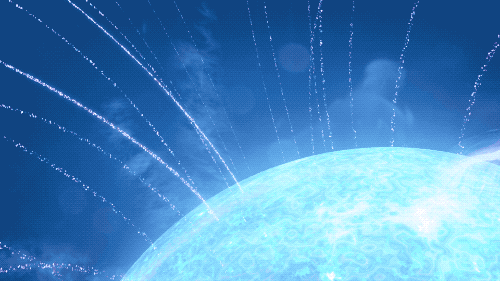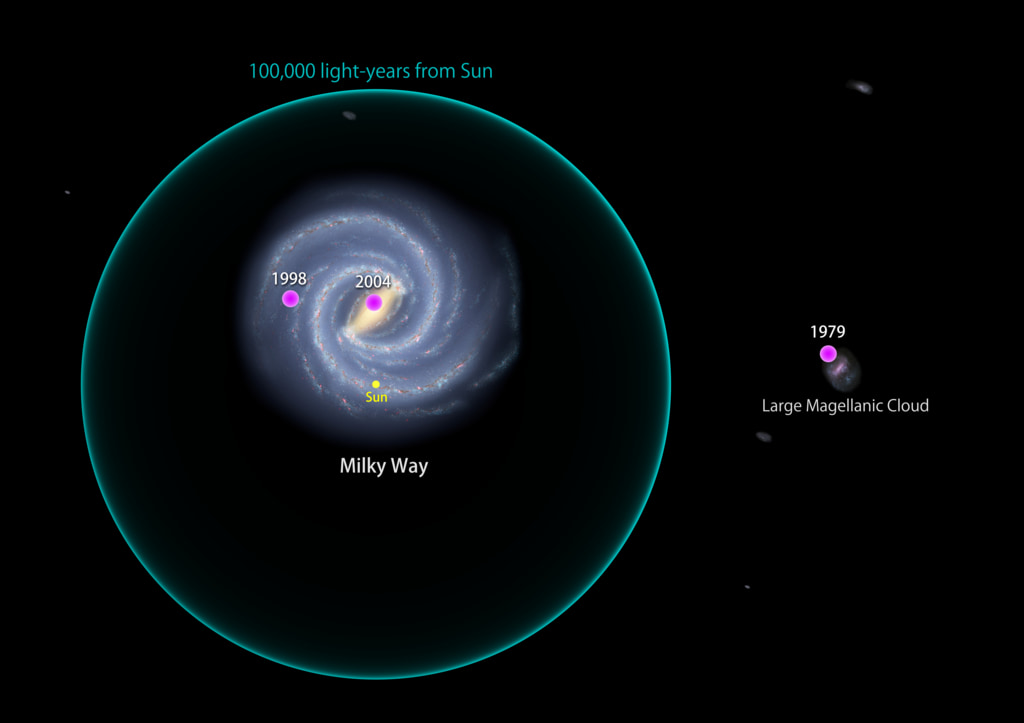Scientists have seen all sorts of monsters in the universe and starquakes are phenomena worth mentioning. What is a starquake? Well, from what we know so far, a starquake happens on magnetars which is a type of neutron star that has the strongest magnetic fields in the universe. Magnetars also are the densest stars in the universe with the strongest crust. It may be weird to think of a star with a “crust” because they’re essentially giant balls of gas and plasma. However, that’s just how dense they are. These things are small too — about the size of a town — and when the crust is twisted, cracked slightly, or adjusted in any way you get a starquake! Actually, it’s the same principles on how earthquakes happen — except we’re talking about a monster that could easily wipe out a solar system.
Credit: NASA
For those wondering what a neutron star is it’s a star that goes supernova and leaves behind a core. The core becomes so dense that the electrons and protons actually combine together to form neutrons — hence the name neutron star (eh see what we did there?). A neutron star that has the mass of our Sun would only be 16 km across or about 10 miles across.

Animation Credit: NASA
Starquakes are no joke. In fact, there is a famous starquake story that has been told many times. It happened on December 27th, 2004. For a split second, a blast of energy knocks every satellite offline, radios, submarine communications, and shifted the Earth’s magnetic field. A few minutes go by and everything goes back to normal. “What was that?” scientists asked themselves. Immediately every researcher got their hands on a telescope or satellite and pointed it in that direction.
A man by the name of David Palmer, an astrophysicist who works at Los Alamos National Laboratory, got an email and was asked if the pulse detection software he built for the SWIFT satellite picked up anything odd that day. As luck would have it, the satellite wasn’t facing in the direction of the energy blast. However, the energy blast was so intense that gamma rays actually went through the satellite. So much so that it would take our Sun 150,000 years to produce that much! All the scientists around the world deduced that the massive amount of radiation was caused by a starquake. Only two other starquakes were known in the community at the time. One in 1979 and another in 1998.

Credit: NASA
Okay, so what happens when a starquake occurs? Well, going back to our earlier point around magnetars having the hardest crust in the universe, in fact, an iron crystal crust. Scientists have learned these quakes happen for two reasons:
- Magnetic fields so strong it cracks the crust – magnetar’s have such intense magnetic field that it’s 1 trillion times of Earth’s. Scientists measure magnetic fields in tesla. If you wanted to levitate a frog with just a magnetic field you would need 16 Tesla. Neutron stars have 1,000,000 tesla and magnetars would have 100,000,000,000 tesla. You can imagine what these magnetic monsters could do to even the strongest material in the universe.
- Magnetars slowing down their spin slightly causes the shape of the star to change and then break the crust. They spin about 43,000 times per minute. However, when the magnetar spin slows down to even a fraction of a second, that’s when you start having problems. It’s amazing that’s all it takes.
Now, here’s what this might look like via NASA’s animation.
The star crust breaks and shifts under pressure. Then when the crust heats up and finally tears, a fireball of electrons, photons, and plasma emerges as a bubble on the side of the magnetar. An intense bright beam of radiation goes along with it as it releases this energy and travels at 99% of the speed of light. It eventually intersects with the bow shock or where the interstellar gas gathers all up. As a result of hitting the bow shock, it then produces gamma rays. This is all still to the best understanding that we have today of what starquakes can do.
There are also sunquakes that are similar to starquakes except they don’t release a coronal mass ejection. Not only that but there are venusquakes, marsquakes, and even moonquakes! Although all these quakes have varying degrees of destruction, it also helps scientists understand is what’s happening in the core of the planet, star, or neutron star / magnetar as a result of using seismometry. We use the same technique here on Earth to understand what our core is like since we can’t just drill a hole.
For now, we continue to look up at the night sky and imagine that these beautiful bright stars are not only majestic but can also be erupting with starquakes and causing mass destruction for its surrounding area. Astrophysicists continue to monitor and find all the pulsars and magnetars and study them further to understand how they work but also how this may impact us.
